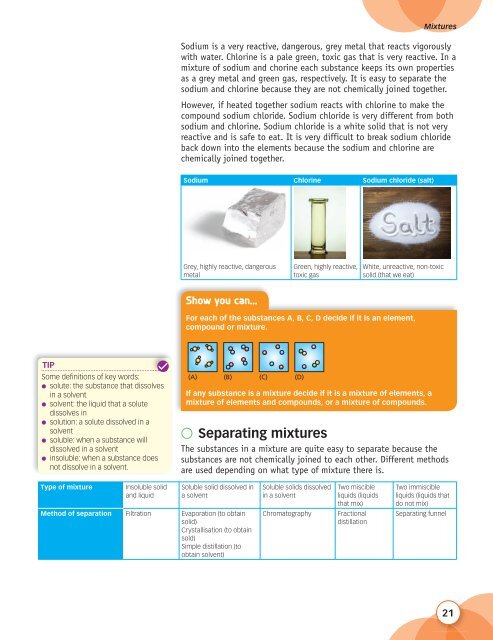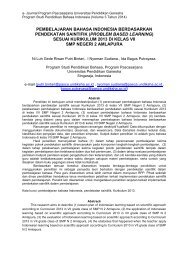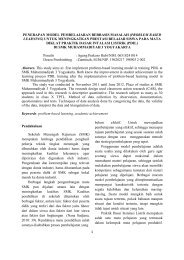Create successful ePaper yourself
Turn your PDF publications into a flip-book with our unique Google optimized e-Paper software.
Mixtures<br />
Sodium is a very reactive, dangerous, grey metal that reacts vigorously<br />
with water. Chlorine is a pale green, toxic gas that is very reactive. In a<br />
mixture of sodium and chorine each substance keeps its own properties<br />
as a grey metal and green gas, respectively. It is easy to separate the<br />
sodium and chlorine because they are not chemically joined together.<br />
However, if heated together sodium reacts with chlorine to make the<br />
compound sodium chloride. Sodium chloride is very different from both<br />
sodium and chlorine. Sodium chloride is a white solid that is not very<br />
reactive and is safe to eat. It is very difficult to break sodium chloride<br />
back down into the elements because the sodium and chlorine are<br />
chemically joined together.<br />
Sodium Chlorine Sodium chloride (salt)<br />
Grey, highly reactive, dangerous<br />
metal<br />
Green, highly reactive,<br />
toxic gas<br />
White, unreactive, non-toxic<br />
solid (that we eat)<br />
Show you can...<br />
For each of the substances A, B, C, D decide if it is an element,<br />
compound or mixture.<br />
TIP<br />
Some definitions of key words:<br />
● solute: the substance that dissolves<br />
in a solvent<br />
● solvent: the liquid that a solute<br />
dissolves in<br />
● solution: a solute dissolved in a<br />
solvent<br />
● soluble: when a substance will<br />
dissolved in a solvent<br />
● insoluble: when a substance does<br />
not dissolve in a solvent.<br />
(A) (B) (C) (D)<br />
If any substance is a mixture decide if it is a mixture of elements, a<br />
mixture of elements and compounds, or a mixture of compounds.<br />
● Separating mixtures<br />
The substances in a mixture are quite easy to separate because the<br />
substances are not chemically joined to each other. Different methods<br />
are used depending on what type of mixture there is.<br />
Type of mixture<br />
Insoluble solid<br />
and liquid<br />
Soluble solid dissolved in<br />
a solvent<br />
Method of separation Filtration Evaporation (to obtain<br />
solid)<br />
Crystallisation (to obtain<br />
sold)<br />
Simple distillation (to<br />
obtain solvent)<br />
Soluble solids dissolved<br />
in a solvent<br />
Chromatography<br />
Two miscible<br />
liquids (liquids<br />
that mix)<br />
Fractional<br />
distillation<br />
Two immiscible<br />
liquids (liquids that<br />
do not mix)<br />
Separating funnel<br />
21





